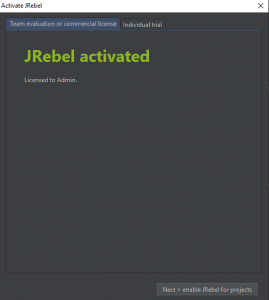

Now let’s make a simple functional change to the application.
#Jrebel android install
If you didn’t use Run with JRebel for Android to install the application yet, Apply changes will take care of the installation on your behalf. The Apply changes button is the key when using JRebel for Android, it will do the least amount of work possible to make your changes and updates visible on your device.

So pressing Run with JRebel for Android on the Google IO 2015 application would result in the following: For a detailed overview of how JRebel for Android works, read this under the hood post. In addition no changes are required to your project.
#Jrebel android apk
JRebel for Android will only run with a debuggable flavor, so your release apk is never affected. To update your code and resources, JRebel for Android needs to process the project’s classes and embed an agent to the application. So you’ll be faced with the same run flow, where you first need to pick a device and then apk is built and installed on that device etc. Run with JRebel for Android is the same as the Run action in Android Studio. Now the plugin is installed, you just need to click the Run with JRebel for Android button, which will always build a new apk if changes are detected between the previous installation. Running My Application With JRebel for Android After restart, you need to provide your name and email to get your free 21 day trial of JRebel for Android. Once the plugin is installed, you’ll need to restart Android Studio, as usual after a plugin installation. After which you need to install via the Plugins > Install plugin from disk… route. If for some reason you can’t access the public maven repositories you can download it directly from the JetBrains homepage. You can download it directly from the IDE by navigating to Plugins > Browse Repositories and searching for “JRebel for Android”. JRebel for Android is available as a plugin for Android Studio. Let’s take the Google IO 2015 app and see how the JRebel for Android setup works as well as how it can save you valuable time. This logic is nothing new and has been present in the Java EE/SE and JRebel for more than 8 years. Instead, the APK gets installed once and delta packages are shipped over to the device or emulator and are applied during runtime. It takes a different approach by not introducing a new apk after each change. One thing you can try is JRebel for Android. For example, having annotation-based dependency injections are nice to have for a cleaner architecture, but it has an impact on your build time. Although you can win back seconds and maybe even minutes, some bottlenecks will still remain in your build. There are some great posts on this, including, “ Making Gradle builds faster”.
#Jrebel android how to
The interwebs are packed full with suggestions of how to squeeze the most out of your Gradle builds. This puts you in the position where you spend most of your time figuring how to make your build run faster rather than adding more value to your actual app.

As the functionality of your project grows you’ll find that your build times follow suit. Android development is great as long as your project stays relatively small.


 0 kommentar(er)
0 kommentar(er)
